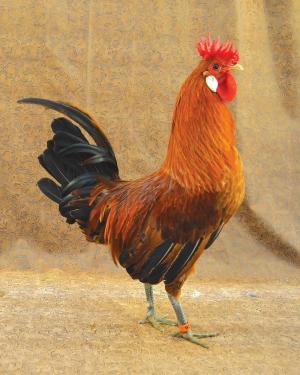Buttercup Chickens: A Rare Backyard Breed
 ✖  |
Sicilian buttercup chickens are a rare old-world breed still finding their way into U.S. backyard flocks today. The bird’s distinctive cup-shaped comb and golden plumage are reminiscent of the flower blossom that gave the breed its name. The buttercup comb is made of two single combs that connect over the beak and in the back. On the most show-worthy birds, this forms an even “crown” of regularly spaced points on top of their head.
Unlike many chicken breeds, buttercup hens and roosters are different colors. Roosters are reddish-orange with black tails, while hens are golden with black spangles across their back. But what both sexes have in common are striking green legs with yellow feet.
This heritage bird hails from Sicily. Sicilian farmers bred birds with similar combs as the Buttercup for centuries but didn’t actively select for the yellow comb and green legs that the breed is now known for.
Buttercups were first introduced to the United States around the 1830’s when they were brought on a ship to provide meat for the passengers. However, their friendly nature and large eggs soon won them fans, and the passengers decided to continue raising them on land.
A buttercup chicken breed club was formed in 1912 that quickly amassed hundreds of members. By 1918, buttercup chickens were recognized in the American Poultry Association Standard of Perfection. A bantam variety was developed in the mid-1900’s and gained admittance to the APA Standard in 1960. However, their popularity was short-lived, and the breed slowly lost traction in the United States to more prolific egg-layers. These non-broody birds will produce between 140 to 180 eggs a year, making them a fairly mediocre producer.
Buttercup chickens don’t do well in the cold. They’re excellent foragers that thrive in free-range conditions, especially when given access to a compost pile to scratch around in. Just be warned they might not stay out of your landscaping. Personality can vary significantly by bird, with some strains being friendly and inquisitive around people and others semi-feral. Socialize them early, and they should do well in your yard.
Like many heritage breeds, buttercup chickens fell into near-obscurity in the 20th century as commercial egg production began to take off. A few dedicated breeders kept the strain from facing extinction and contributed to their resurgence today.
While Buttercups remain rare, it’s possible to find breeders nationwide. Connect with the Livestock Conservancy to learn more about this special Sicilian chicken.
Contact: FARM SHOW Followup, The Livestock Conservancy, P.O. Box 477, 33 Hillsboro St., Pittsboro, N.C. 27312 (ph 919-542-5704).

Click here to download page story appeared in.
Click here to read entire issue
Buttercup Chickens: A Rare Backyard Breed LIVESTOCK Poultry Sicilian buttercup chickens are a rare old-world breed still finding their way into U S backyard flocks today The bird’s distinctive cup-shaped comb and golden plumage are reminiscent of the flower blossom that gave the breed its name The buttercup comb is made of two single combs that connect over the beak and in the back On the most show-worthy birds this forms an even “crown” of regularly spaced points on top of their head Unlike many chicken breeds buttercup hens and roosters are different colors Roosters are reddish-orange with black tails while hens are golden with black spangles across their back But what both sexes have in common are striking green legs with yellow feet This heritage bird hails from Sicily Sicilian farmers bred birds with similar combs as the Buttercup for centuries but didn’t actively select for the yellow comb and green legs that the breed is now known for Buttercups were first introduced to the United States around the 1830’s when they were brought on a ship to provide meat for the passengers However their friendly nature and large eggs soon won them fans and the passengers decided to continue raising them on land A buttercup chicken breed club was formed in 1912 that quickly amassed hundreds of members By 1918 buttercup chickens were recognized in the American Poultry Association Standard of Perfection A bantam variety was developed in the mid-1900’s and gained admittance to the APA Standard in 1960 However their popularity was short-lived and the breed slowly lost traction in the United States to more prolific egg-layers These non-broody birds will produce between 140 to 180 eggs a year making them a fairly mediocre producer Buttercup chickens don’t do well in the cold They’re excellent foragers that thrive in free-range conditions especially when given access to a compost pile to scratch around in Just be warned they might not stay out of your landscaping Personality can vary significantly by bird with some strains being friendly and inquisitive around people and others semi-feral Socialize them early and they should do well in your yard Like many heritage breeds buttercup chickens fell into near-obscurity in the 20th century as commercial egg production began to take off A few dedicated breeders kept the strain from facing extinction and contributed to their resurgence today While Buttercups remain rare it’s possible to find breeders nationwide Connect with the Livestock Conservancy to learn more about this special Sicilian chicken Contact: FARM SHOW Followup The Livestock Conservancy P O Box 477 33 Hillsboro St Pittsboro N C 27312 ph 919-542-5704
To read the rest of this story, download this issue below or click
here to register with your account number.







